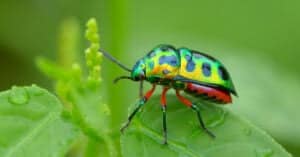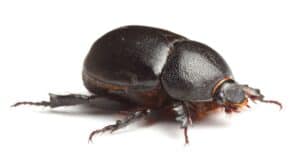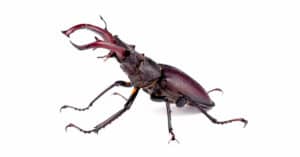The cigarette beetle and the drugstore beetle are two beetles that look so much alike that they are almost indistinguishable. However, despite the closeness of their physical appearances, there are still areas where they are profoundly different from one another.
By the end of this article, you’ll be able to spot the significant differences between these insects and identify their similar characteristics.
Comparing Cigarette Beetles and Drugstore Beetles
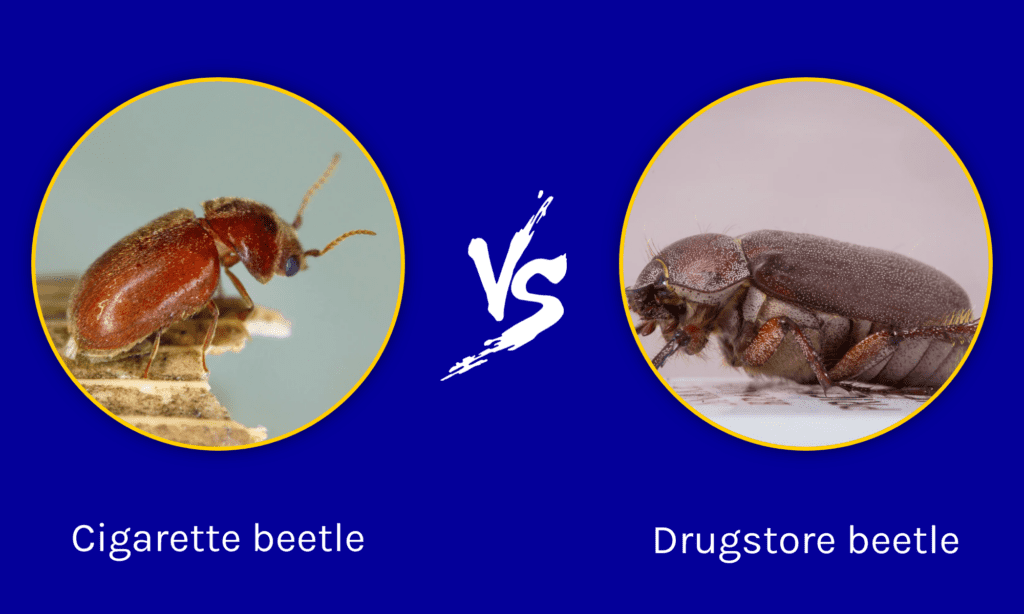
| Cigarette Beetles | Drugstore Beetles | |
|---|---|---|
| Physical appearance | Serrated antennae and smooth wing cover | 3-segmented antennae and lined wing cover |
| Reproduction | 10-100 eggs are typically produced by the female | The female produces about 75 eggs |
| Scientific name | The scientific name is Lasioderma serricorne | The scientific name is Stegobium paniceum. |
Key Differences Between the Cigarette Beetle and the Drugstore Beetle
The physical appearance of the cigarette beetle and the drugstore beetle have just two major differences. The first is that the antennae of the cigarette beetle are serrated (something such as the teeth on a saw), while the antennae of the drugstore beetle are not. Furthermore, the antennae of the drugstore beetle end in a 3-segmented club. The other difference is that the wing covers of the drugstore beetle have rows of pits giving them a lined appearance, while those of the cigarette beetle are smooth. The wing covers of these insects are referred to as elytra.
Other significant differences between cigarette beetles and drugstore beetles include:
Cigarette Beetles vs Drugstore Beetles: Reproduction
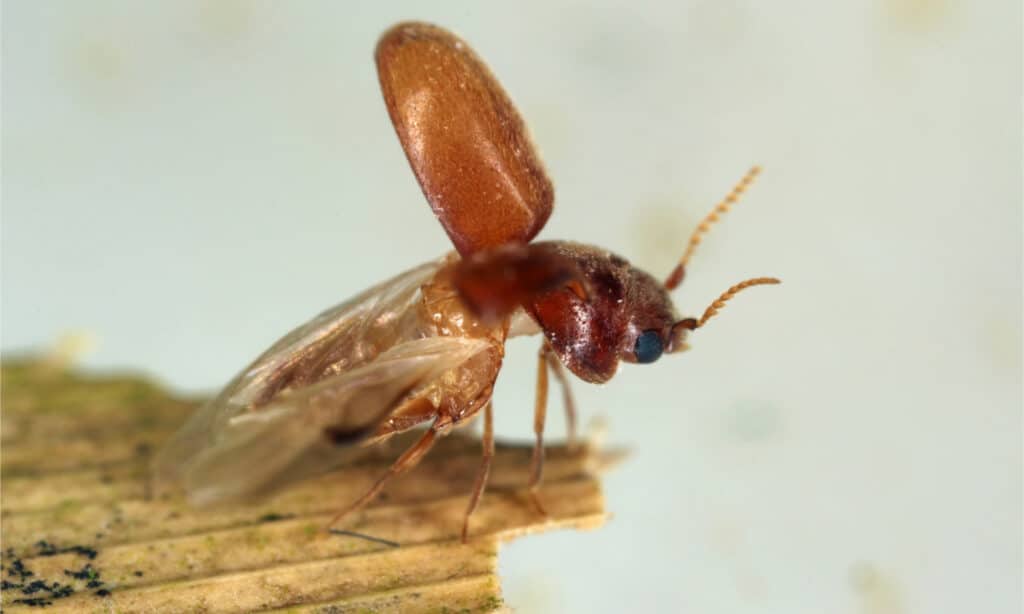
Cigarette beetles lay 10 to 100 eggs with a gestation period of about 10 days.
©Tomasz Klejdysz/Shutterstock.com
Female drugstore beetles lay up to 75 eggs with a gestation period of just a few days. The entire lifecycle of the drugstore beetle is usually below two months, although some live as long as seven months under certain conditions. On the other hand, cigarette beetles lay 10 to 100 eggs with a gestation period of about 10 days. The entire lifecycle of the cigarette beetle is typically two to four months.
Cigarette Beetle vs Drugstore Beetle: Scientific Name
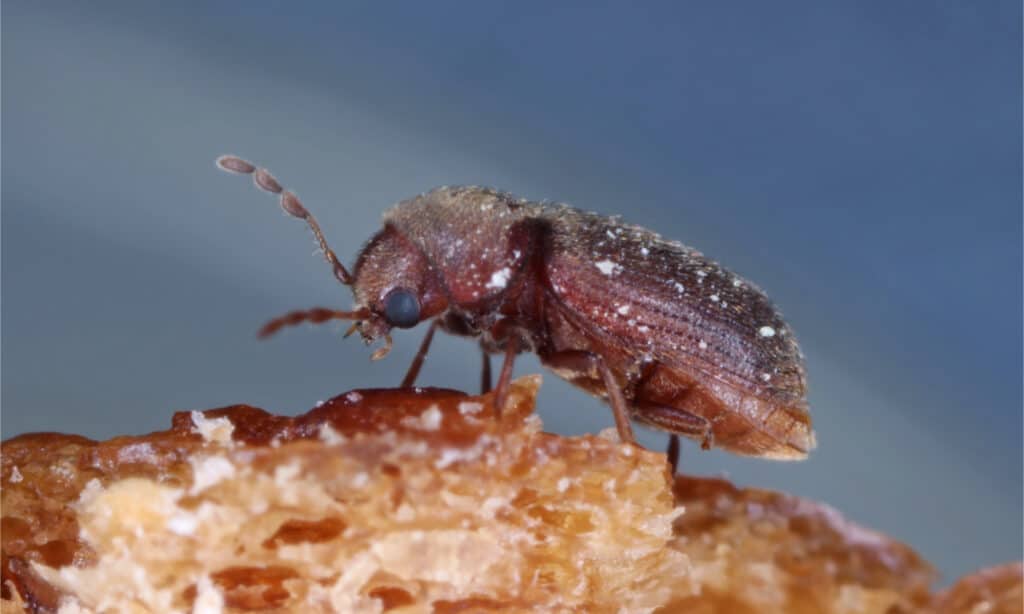
The drugstore beetle belongs to the Anobiinae subfamily.
©Tomasz Klejdysz/Shutterstock.com
This is the final difference that we will explore concerning these two insects. The scientific name for the cigarette beetle is Lasioderma serricorne, while that for the drugstore beetle is Stegobium paniceum. They also belong to different subfamilies with the cigarette beetle’s subfamily being Xyletininae, while that of the drugstore beetle is Anobiinae.
Although it is not a scientific name, you should note that the drugstore beetle is also referred to as the biscuit beetle.
What is Common to Both the Cigarette Beetle and the Drugstore Beetle
These insects have more in common than they have differences. This is not too surprising since they belong to the same scientific family and order, namely Ptinidae and Coleoptera respectively. One of the primary similarities between both insects is the penchant for destruction as pests.
Both insects attack a wide variety of food and other materials. The drugstore beetle, for instance, got its name for a habit of destructively feeding on prescription drugs. Similarly, the cigarette beetle earned its name for the damage that it does to stored tobacco.
Some of the food materials that are commonly on the diet of these insects include flours, dry mixes, chocolates, cookies, sweets, spices, rice, cocoa, coffee, cereals, nuts, etc. Furthermore, non-food materials eaten by these insects include wool, horn, leather, hair, aluminum sheets, books, prescription drugs and pills, dried floral arrangements, potpourri, medicinal herbs, pinned insects, furniture stuffing, and paper-mâché, amongst others.
Lastly, both insects have symbiotic yeasts that produce Vitamin B which are consumed by their larvae as the egg hatches. The implication of this is that cigarette beetle and drugstore beetle can feed and survive on materials of low or no nutritional quality.
Other similarities between both insects include:
They are nocturnal: Both beetles go about their activities at night. The drugstore beetle is particularly attracted to light at night.
They are similar in length: The cigarette beetle and the drugstore beetle are of very similar length. The drugstore beetle is 2.25 to 3.5 mm (0.08 to 0.14 inches) long and the cigarette beetle is 2 to 3 mm in size (0.08 to 0.11 inches).
They have the same predators: They both have several predatory insects that attack them, such as some kind of mites, checkered beetles, and darkling beetles. Some of their other predators are wasps that lay eggs on top of beetles so that they may consume them.
They are not dangerous: The cigarette beetle and the drugstore beetle are both harmless to human beings. They don’t bite or sting except if you are a plant. They also do not carry diseases. However, when they infest food, they contaminate it.
They have the same habitat: You will find the cigarette beetle and the drugstore beetle all over the world, especially in places where they have access to their food source.
Treatment: How to Prevent and Get Rid of Cigarette Beetles and Drugstore Beetles
It is relatively easy to prevent or control cigarette beetles or drugstore beetles from infesting a home. The most commonly known way to get rid of them is to resort to insecticides. However, insecticides should only be used as a last resort. Some other tips that will help include:
- Locate the source of the infestation.
- Items that have been heavily infested should be wrapped in heavy plastic, removed from the building, and disposed of.
- It is important to inspect all food containers and items for possible infestation.
- You can place the items in the refrigerator or freezer for a while to kill all stages. The recommended periods are; 7 days at 25°F, 16 days at 36°F, or four to seven days at 32°F.
- To prevent condensation issues during thawing, place items in a plastic bag.
- Small quantities of infested material can also be heated in an oven. The recommended periods are 190°F for one hour, and 120°F for 16 to 24 hours.
- To prevent reinfestation, clean up spilled flour, mixes, crumbs, etc., and vacuum and thoroughly clean the areas where the contaminated items were stored.
- Foods should be stored in airtight plastic, glass, or metal containers. Clear containers make it easier to detect infestations.
The photo featured at the top of this post is © Tomasz Klejdysz/Shutterstock.com
Thank you for reading! Have some feedback for us? Contact the AZ Animals editorial team.



